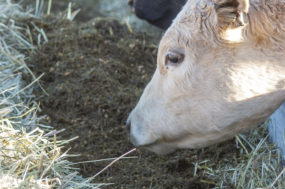Kelly Tiller, CEO of Genera Energy and director of external operations for the UT Office of Bioenergy Programs, said, “The University of Tennessee Biofuels Initiative is the only fully integrated program that is working with farmers and the agricultural industry to reliably supply the necessary feedstock so biorefineries can produce plentiful, affordable, renewable and sustainable fuels.” She said plans are for Tennessee farmers to place an additional 4,000 acres of switchgrass into production this spring, bringing the total production in the state to nearly 7,000 acres of the dedicated energy crop.
—From DDCE press release
Virginia fertilizer sales fall in ’09, higher cost cited
Sales of fertilizer products in Virginia fell by 16 percent during the 2008-2009 fiscal year.
State data show that 692,033 tons of fertilizer products were sold between July 1, 2008 and June 30, 2009, compared to 802,323 tons during the previous fiscal year.
Fertilizer products sold for farm use declined by 22 percent, from 498,871 tons to 407,402 tons. Sales for non-farm use dropped from 303,452 tons to 284,631 tons, a 6 percent decline.
Jonah Bowles with the Virginia Farm Bureau Federation says cost was a major factor in the decline of farm use tonnage. He says the fertilizer index of prices in August 2008 was five times higher than in November 2006.
—From AP newswire
Ag Department seeking change to water rights
After state budget cuts slashed a program that had allowed irrigators to conserve water without falling under state “use it or lose it” requirements, Kansas Agriculture Department officials have come up with another idea to solve the quandary.
In a move that marks a substantial shift in water policy, agency Secretary Josh Svaty and the department introduced legislation to the Senate Agriculture Committee that would recognize conservation of water as a beneficial use.
At present, the state can consider water rights abandoned after five consecutive years of nonuse. Previously, however, irrigators – largely in over-appropriated areas – could suspend their water rights for five to 10 years by enrolling in the Water Rights Conservation Program. Users retai ned ownership and could begin pumping again, if they so chose, after the contract period ended.
“In the past, water rights holders have been required to put to beneficial use their water right or risk losing the right to abandonment,” Svaty said in a statement. “We are asking the Legislature to approve a statutory change that would recognize conservation as a beneficial use.’’
The program would be voluntary, giving producers the opportunity to save water for future use or future generations without the risk of losing the property right.
—From The Hutchinson News
Grazing fees on public lands unchanged for 2010
Federal officials say livestock grazing fees on public lands across the West and much of the Midwest will remain unchanged in 2010 for the fourth year running.
The $1.35 per head monthly fee applies to land in 16 states administered by the Bureau of Land Management and Forest Service. The two agencies authorize grazing on about 250 million acres nationwide.
Conservation groups criticize the program as a government giveaway that fails to reflect grazing’s environmental costs. Livestock producers counter that they put public lands to good use and are responsible stewards.
The fee is tied to cattle prices. But BLM spokesman Tom Gorey says because those prices have been low, the fee would likely be substantially less if not for a 1986 Executive Order that set $1.35 as a minimum.
—From AP newswire
Researchers turning up heat on weeds
A team of University of Nebraska researchers is trying to light a fire under a weed-control strategy that uses propane-fueled flames to kill weeds.
UNL weed scientist Stevan Knezevic said the idea actually dates back at least as far as the mid 1900s. But it got pushed aside as the chemical approach and bigger and bigger pesticide sprayers moved into the market.
The best market potential now is among organic producers who don’t use those chemicals. At this stage, the best results are in corn, sweet corn, popcorn and grain sorghum fields.
“It’s not so much the fire as it is the amount of heat produced that does the damage to the weeds,” said Larry Stanislav, one of four Butler County crop producers involved in recent field trials.
The equipment might remain too small for conventional farmers doing weed control on thousands of acres. “But organic producers are the ones that are interested, because organic, by definition, cannot use synthetic chemicals.”
—From Lincoln Journal Star
Minnesota man helps rebuild agriculture in Afghanistan
Paul Kanninen usually lives on the flat prairie of southwestern Minnesota. This winter, though, he’s high up in the Hindu Kush mountains in Afghanistan, working to help rebuild an agricultural sector that’s struggling after decades of war.
Kanninen, 58, of Luverne, Minnesota, works for the U.S. Department of Agriculture as a plant protection specialist with the Animal and Plant Health Inspection Service. But he answered a call for volunteers from the USDA’s Foreign Agricultural Service, which sent him to Afghanistan in late December to serve for 13 months on a Provincial Reconstruction Team.
The predominant crop in the area is winter wheat, which was sown last fall and now lies dormant under the snow and will be harvested around July, he said. Livestock grazing is also a major local industry – mainly sheep and goats with some cattle – and overgrazing has been a problem. So, Kanninen said, their third goal is improving grazing practices, particularly to increase the amount of vegetation in the hills so spring runoff doesn’t lead to flooding.
—From AP newswire
New invasive weed identified in North Dakota
Booming oil activity in western North Dakota in recent years has boosted the state’s economy. But it might be to blame for the introduction of an invasive weed.
Halogeton has been found in most western U.S. states but had never been spotted in North Dakota until late last summer, when a federal official found it in the Little Missouri National Grasslands.
Halogeton is a weed that grows about two feet high, has red stems, blue-green leaves and small yellow flowers. It produces seeds that can be spread various ways, including through wind, water and human activities. Spraying or pulling the weeds by hand are the only ways to get rid of it. Cattle, sheep and wildlife that feed on plants can die if they eat enough halogeton.
Officials hope the weed can be eradicated, though the chances depend on how long halogeton has actually been in North Dakota.
—From AP newswire
Report says grasslands can help combat climate change
A new report from the United Nations Food and Agriculture Organization says grasslands have vast untapped potential to limit climate change by absorbing and storing carbon dioxide.
“Grasslands represent the majority of the world’s agricultural area and they hold an enormous amount of the soil carbon, so we have a fantastic potential to have both better livelihoods and a better natural resource base while mitigating and adapting to climate change,” said Constance Neely, who co-authored the report.
She says livestock is one of the key factors blamed for land degradation, but that if properly managed, livestock is good for soil.
“You’re taking advantage of three things,” she said. “One, you’re getting the hoof action on the soil, so often you’re breaking a soil crust which allows the rainfall that does come to actually go into the soil. And you’re getting the manure and you’re getting the urine as well, which is fertilizing the soil.”
—From Voice of America










